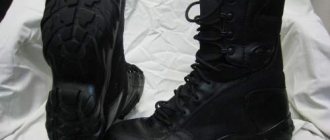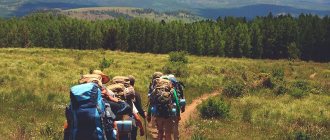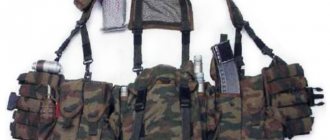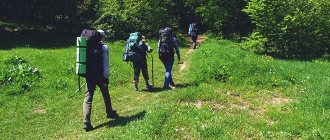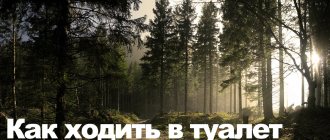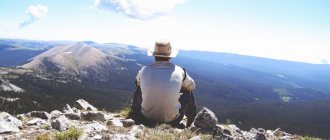Why do people go camping alone?
What pushes people to renounce civil goods and completely immerse themselves in the bosom of Mother Earth, what leads to this spontaneous desire to be left alone with nature, to become a tiny part of something absolutely huge, infinite? There may be a desire to plunge into the green world, feel unity with the Creator, and find answers to many questions. Only a solo trip will help with this, when the company will not distract from contemplation and knowledge of the surrounding beauty, knowledge of oneself.
From the diary of Gennady Kuzmin. Day 1
The weather is cloudy, which is very good for the cycling stage. The bike is a little overloaded (5 kg of packraft (a type of inflatable boat - Ed.) + about 20 kg of equipment), which affected the speed, and 1/3 of the road is gravel. Then 2 hours of rest on an empty train to Ugleuralskaya.
Further 20 km of good asphalt to Kizel and... here is the first surprise and difficulty - post-war paving stones, broken, laid by captured Germans, plus long descents and ascents. The speed dropped to 5-10 km/h.
And so on to Severnoye-Kospashsky, the last barely alive village on my way, in which I did not notice any signs of life. Only the hare threw itself right under the wheels, apparently out of despair.
And then - 35 km along an old broken embankment road among swamps and forests cut down by prisoners, with destroyed bridges, puddles of tens of meters, long climbs. We met several jeeps and trucks; in case of unforeseen situations, there is someone to help. And there is also an animal: about 50 meters ahead, a bear crossed my path. I shouted to him to wait, but he just glanced at me from the bushes and silently disappeared.
The day ended at 10 pm on the Nyar River. Hard – total mileage 90 km.
Psychological difficulties of a solo hike
At first, you will feel loneliness especially acutely; it will press on your consciousness like an annoying headache; it will twist you inside out and squeeze you to the point of psychological exhaustion; you will be disturbed by sudden flashes of memories from the past. This will not last long at all, but it will become a historical event in your life.
Soon your loud and fast thoughts will suddenly stop, as if you will open your eyes again and see that in this world there is simply no such thing as loneliness, and everything around you will be filled with living meaning. The sky will become your friend, every tree will speak a language you understand, you will understand the depth of meaning of birdsong, everything will be filled with rich colors, and most importantly, your thoughts will find lightness and your soul will find peace.
Other difficulties of this path
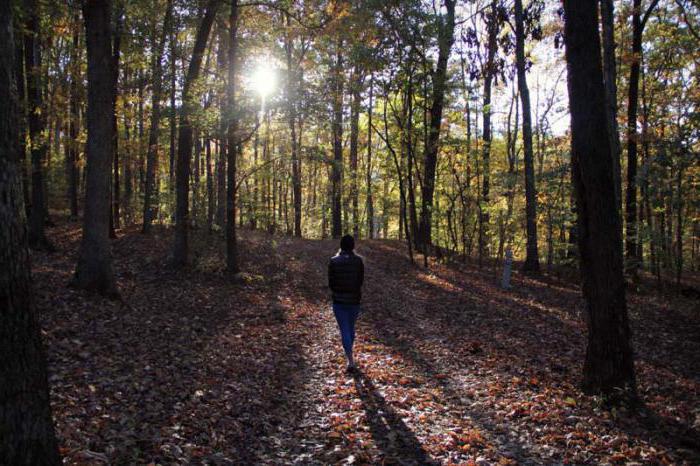
This is the main one of the many psychological difficulties that you will have to overcome; everyone who decides to go the path alone faces it. There are actually quite a few of them:
- giving up your usual comfort may seem quite difficult for some;
- fear of unsterility, insects, heat;
- fear of diseases;
- physical unpreparedness;
- inability to navigate the terrain;
- ignorance of the basic rules of behavior in the forest, in the mountains, on the water.
It’s very difficult to give practical advice on how not to worry about such things, everything is purely individual, everyone has their own complexes, you just have to remember that you can always get rid of them, if that’s what you want, of course.
Physical exercise
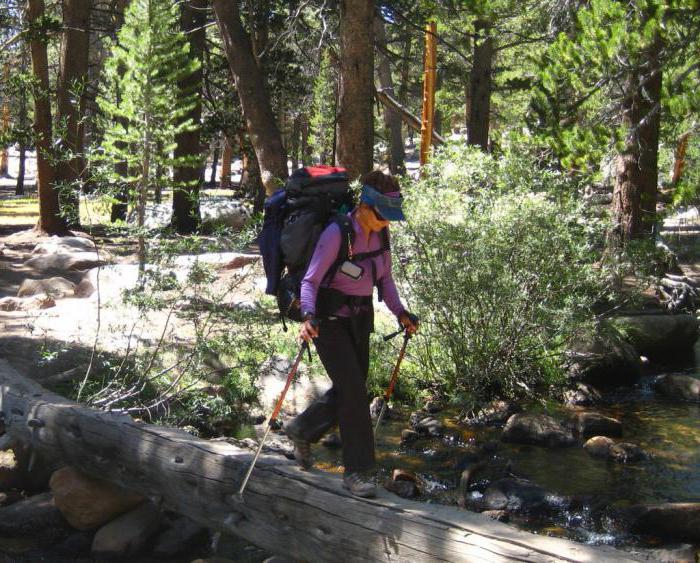
Psychological and mental barriers are only half the battle on the way to achieving your goal; it is problematic to prepare for them in advance, which cannot be said about your physical condition. Your body is the main tool through which you understand the world around you. It’s just worth preparing it. First you need to determine how much time you are willing to devote to the hike; this will make it clear how much and what equipment, what provisions you will take with you. The weight of the backpack largely determines the difficulty of the hike.
When everything becomes clear with this, you need to start preparing. Work with the weight you have to carry. You can go to the gym, or you can just load up your backpack and carry it vigorously on your shoulders for several days. Particular attention should be paid to the usual warm-up complexes, with the help of which you will warm up, strengthen your muscles and increase the level of normal tone. Do a good job of warming up your lumbar muscles, as most of the weight of the backpack will be on your lower back and shoulders. To prepare your legs for excessive stress, long walks, with or without a loaded backpack, as well as exercises with a skipping rope are suitable.
Tent and sleeping bag
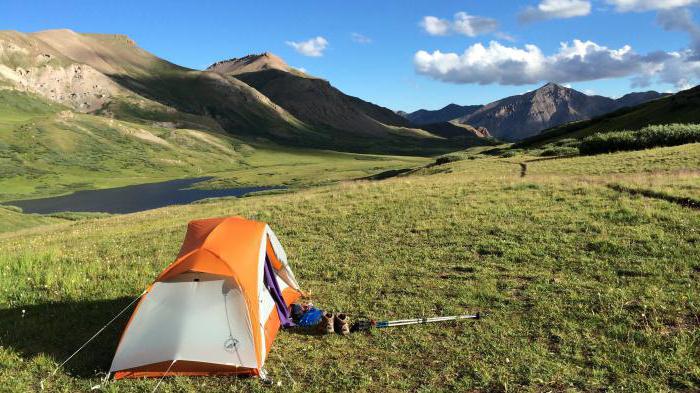
Having chosen a route, you can start packing your backpack. If the trip is for one night, then a small backpack (40-50 l) is enough. A standard set of equipment for an overnight trip includes:
- Tents - there are completely different types, it is better to take a single-person one (less weight), they are divided into categories: high-mountain, mid-mountain, and for the plain. High-altitude tents are characterized by increased wind resistance, reinforced frames and significant weight. Mid-mountain tents are something between a high-mountain tent and a lowland tent; they have average weight and good resistance to rain and wind. Tents for the plains withstand rain and high humidity well, standard tourist tents, an excellent option if you are planning a solo trip to the forest with an overnight stay. Camping for the night is set up in a dry place, protected from the wind as much as possible. The tent is set up with an exit to the opposite side from gusts of wind.
- Sleeping bag - there is a sleeping bag for each season of the year. There are completely different variations. The price implies quality, it is better not to save money, the sleeping bag is more expensive and more comfortable and protects better. The main thing is to choose the right size.
- A karemat is a travel mat that you can sleep on in a tent or put it under your sleeping bag. Guarantees heat and moisture insulation. The most popular variety is “Izhevsk”. Budget-friendly, durable sleeping mats, suitable for almost any hike.
A solo hike without an overnight stay can be done without a tent and sleeping bag, replacing them with a hammock. You can even do without a hammock, but in this case it is advisable to take a rain awning.
Nodoga 2014
A solo hike along wolf tracks and the Nodoga river into the taiga of the Kostroma forests.
These taiga wild places cover an area of 2500 square meters. km. The locals themselves call it “the bear’s corner.” It's full of animals and adventures. Everything here is fabulously beautiful, but there are dangers around every turn. By going here, you will get a lot of impressions that will last a long time! The hike took place in November 2014. Initially, everything was supposed to be like this: I land on the Kostroma-Kady highway, reach a clearing, break through the forest and find a stream that will lead me to the Puchega River. Further along the Puchega River I enter Nodoga and, rafting quietly, admire the surroundings and look for adventures all the way to the Volga. But the plans were not destined to come true...
First, I walked about 12-15 km to find the desired stream, which, as I assumed, should flow into the desired river. Getting there and finding the stream turned out to be much easier than I thought. It didn’t take too long to break through the forest, and the road was comfortable. A few days before the departure, frosts hit (-8-10 for November of recent years - exactly frost), puddles and all swampy places simply froze, the damp moss-chomping soil also set and did not squelch or squelch underfoot. I took the swamp boots, I didn’t even bother taking them out, because it was very convenient to walk in boots. When I reached the desired stream, it was already under the ice and covered with wolf tracks. Next, there was a crossing on the ice of the stream for about 10 km. I walked straight along the wolf tracks, which became more and more numerous. The stream either converged into one, clearly visible channel, or spilled over a swampy forest and field. Several times in such places it was necessary to work hard to find the channel. But mostly the wolf tracks helped out. They walked very clearly along the stream and mostly in convenient places. This allowed us to move quite quickly. Although, it didn’t work out without troubles. At first I fell slightly with one leg, and after a couple of kilometers I went under the water up to my knees with both legs, looking at a tree that from a distance seemed like open water. Quickly squeezing the water out of his socks and pouring it out of his boots, he moved on and got to the winter road, which, due to some incredible inattention, he did not see in advance on the map and satellite when he was planning the route. According to the plans, there should have been open water in this place and here I was supposed to start rafting. But the frosts that struck for 3-4 days did not allow the plan to come true. I had to get up for the night and wait for the morning. I got up when it was already dark. I built a simple shelter from a raincoat and rolled out a warm sleeping bag. Dinner was cooked on a gas burner because I decided not to start a fire. I decided because I had nothing to dry except my boots, and I didn’t bother drying my boots. The decision was not made right away and was based on the fact that it would still not be possible to dry them quickly; there is a high probability of the soles coming off if you place them close to the fire. And sitting there drying them all night without resting before the next day would be stupid. The entire next day, when according to the plan there should have been rafting, was spent on foot searching for water. There were thawed patches on the river and the ice was crunching; it was impossible to walk on it. But there was no desire to rush along the overgrown bank; the speed would be extremely low. Therefore, having broken through the forest, I came out to a small clearing leading to the road from the winter road. And then I walked along it for several hours, constantly looking at the compass. The road went in the right direction almost all the time, only at the end starting to go west. In the evening, having reduced a fair distance along the road, water was found. But the joy was premature. It was impossible to call the water open. Areas of open water of 20-30 meters alternated with the same icy ones. And by evening the ice completely closed. By the end of the second day I was where I was supposed to be at the end of the first. On the third day I had to get up at 5 am, when it was still dark, have a quick breakfast, get ready and head out just as dark. The task was: to make up for lost time as much as possible, to try to get on schedule. I had to drag the boat along the shore, and again break through the ice, and even swim a little. On the way, we began to encounter a large number of obstacles in the form of rubble, beaver dams, ice, etc. After lunch, a strong wind blew and snow began to fall. There was less and less water, and more and more runoff. For the last couple of hours I just had to trudge across the ice on foot. Having set up camp on a high bank, we had to make shelter from quite strong wind and snow. Everything turned out quite well, since in the morning everything in the area was covered with snow, except me 

- Rice and buckwheat in boiled bags of 4 pcs.
- Tea, coffee in bags
- A loaf of black bread with caraway seeds
- Smoked sausage
- A pinch of caramel
- Mixed nuts (almonds, hazelnuts, walnuts, cashews)
- Stew 2 cans
- Snickers 4 pcs.
On this trip we tested for the first time:
- Boat "Taiga 280"
- Wei boots
Well, if I already had boots like this before, I bought them 5 years ago, then I only had the boat for the first time. And she showed herself from the very best side. I managed to raft on it and carry it around. It weighs only 5 kg and when folded takes up a little more space than a sleeping bag, it is easy to drag, any obstacles can be simply thrown over, no need to cut through. The tests that started a little earlier continued:
- Sleeping bag "Oymyakon"
- Thermos 0.5 l
The sleeping bag is incredibly warm. At night at -10-12 it was even a little hot in there. I slept without clothes, only on the third night I was wearing a thermal underwear shirt (I fell asleep before I could take it off). The thermos has also proven itself from the best side with its lightness and compactness. And I also had with me:
- Raincoat tent
- Axe
- Hunter Signal
- Knife
- Flashlight
- Short rug
- Inflatable life vest
- First aid kit
- Repair kit
- Oars (blades)
- Pump
- Maps, diagrams, compass
- Burner, gas cylinder
- Kettle, fire rope
- Rope
- Hiking poles
The temperature was approximately the same all the time. At night the average is −10, during the day it is 2-3 degrees warmer. The first day was clear, then it was cloudy all the time. On the third day it started snowing, on the fourth it just fell mercilessly. The wind always blew strong, with the exception of the first day. The clothes were almost all Novaturov's. Fleece suit "Kamchatka" as a running suit, trousers "Nord" (old, version 2008) and jacket "Angara" - for the evening. Thermal underwear "Active Nord". Splavov socks. EVA swamp boots (light and warm).
Similar hikes
In the summer of 2014, a trip was made to the same region, along the neighboring river Zhelvata through a place famous in narrow circles - Ukhtyngir. A video about that trip can be seen here: [RW] Thunderstorms, wolves, Ukhtyngir
Tweet
Other solo hiking equipment

If you have a long stay away from home, you will need some more equipment:
- Terrain map - necessary for orientation on the terrain, locating bodies of water and determining altitudes.
- Compass - no single trip to the forest, mountains or anywhere else can be done without it.
- A gas burner adds additional weight, but will make the hike much easier. In the mountains, rain is a common occurrence; with high humidity, fuel for a fire becomes useless, drying firewood will take a lot of time, but a burner will always serve as an alternative for quick cooking. You can take dry alcohol, which can be used to dry firewood. These items are especially relevant if you are planning a solo trip to the mountains.
- Knife – any strong and sharp knife will do.
- Rope - useful in any situation, from tying up a canopy to using it as a tourniquet.
- Kettle - on a solo trip (to the forest, mountains, lake - it doesn’t matter), it’s better to take a small container (up to one liter), most kitchen pans will do, but it’s better to get an aluminum camping kettle.
- Matches, lighters, flint - everything you might need to start a fire. These items should be isolated from moisture; a good way would be to place them in a regular condominium. By the way, it is useless to take lighter fluids; they add significant weight to the backpack, run out quickly, and do not contribute to the acquisition of experience in lighting a fire in extreme conditions.
Difficulties to prepare for

This is not the other, negative side of a solo hike. This is simply something that needs to be foreseen, something that needs to be prepared for, and something that needs to be, even necessary, experienced. Many who went on a solo hike in the forest for several days noted that the physical difficulties were not as terrible as the psychological ones.
A person who is torn out even of his own free will from his usual surroundings cannot immediately get used to the fact that there will be no answer to his question. No one will give you advice or make an inappropriate joke. There will be no human voices around, which we hardly notice in everyday life, or other familiar sounds of civilization. It will be quite difficult to fall asleep on the first night, no matter how tired you are. But that's not the worst thing. Being alone for a few days and having to rely only on your own pair of arms, a pair of legs and your head can sometimes completely change your outlook on life. It cannot be said that everyone returns from a solo trip a different person, but this also happens.
Well, in addition to psychological difficulties, there are also physical difficulties. It’s much easier to list them, and to deal with them too.
- Location orientation.
- Constant loads.
- Cooking food.
- Advancement over rough terrain, climbing mountains, crossing water obstacles.
- Insect annoyingness.
The list may not be complete, but this is the main thing that even an experienced tourist will have to deal with.
Water while hiking
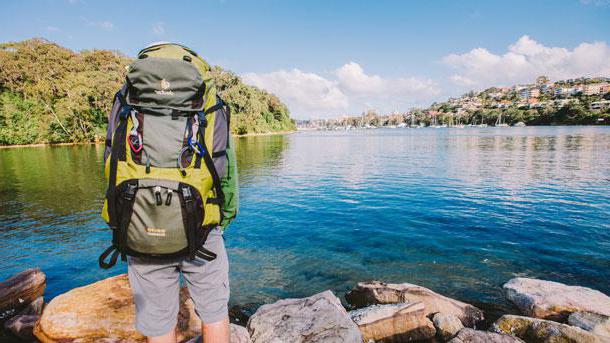
Since a solo trip to the taiga or another secluded place involves your isolation from society for some time, the issue of maintaining health is very relevant. The quality of drinking water plays an important role in this. There is a way to purify water from almost any degree of contamination. Travel stores sell iodine-based tablets, which are dropped into a container of liquid, and after the time indicated on the package (from 15 to 30 minutes), the water is purified and ready for use. You can also get by with regular iodine: 4 drops of the drug per 1 liter of water, wait 10-20 minutes.
Before purifying water from harmful bacteria, it should be filtered through cloth or sand to remove large particles of contamination. After using the tablets, the water must be boiled.
How not to get lost in the forest?

If this is your first time going on a hike in the taiga, then the most important thing is not to get lost. The salvation for any beginner will be the rough paths. Take the time to search for them.
After all, the path you are moving along was laid by a person who knows this area very well, most likely a forester. So don't worry if the trail gets too high or windy at times. This means that going the other way will be much longer and more dangerous.
If you are lost, do not try to find the trail on a whim. It’s better to calmly look around, go back if necessary to find any clues and be sure that you are again moving along a proven path.
Cloth
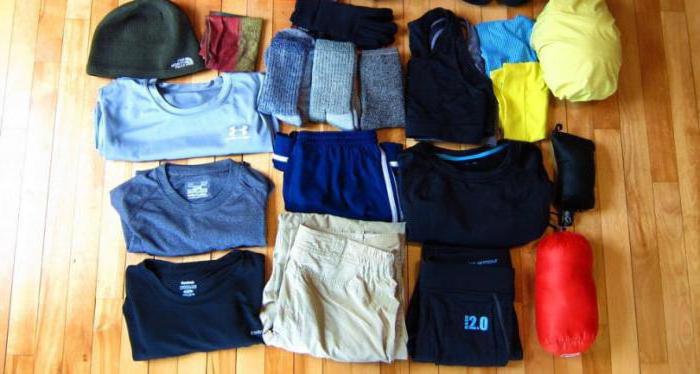
It is important to think about what clothes to take with you on the trip, especially on solo water trips, since it is easy to get clothes wet, but drying them is not always easy. Clothing should be as light as possible, comfortable, water-repellent, and quick-drying. You cannot go hiking in cotton clothes (jeans). It is better to dry wet clothes on yourself, or over a fire, but pay full attention to this. If you are planning a long hike, take a raincoat with you.
It has long been known that wet feet are the main cause of colds. Therefore, you need to carefully choose your main and replacement pair of shoes. Changeable shoes will be useful when moving around the camp; usually these are sandals. Also, replacement shoes will become indispensable when the main pair gets wet.
Carefully choose trekking boots; do not confuse trekking boots with mountaineering boots; the latter are designed for long ascents in mountainous areas, but are less comfortable for hiking on the plain. Of course, you can do without specialized shoes, the main thing is that they are as comfortable as possible and preferably with a high top.
Also take several pairs of socks with you; it is advisable to change them every day.
Weapons for the taiga
When going on an overnight trip to the taiga, many take a gun with them, even if they do not intend to hunt. It must be remembered that the weapon in this case must meet several requirements.
It must be reliable. All mechanisms must operate for a long time without human intervention. If a twisted spring made of thin wire is installed somewhere, then after some time it will certainly rust, and the gun will fail to function at the most crucial moment.
The design of the gun should be as easy to maintain as possible. When traveling, you most likely will not have the opportunity to clean complex mechanisms and disassemble the gun.
The weapon should have a minimum number of small parts, as they wear out the fastest. This rule is especially relevant for self-loading rifles.
Don't forget the first aid kit
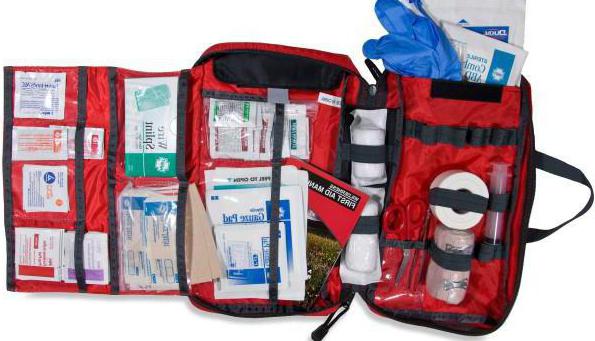
The first aid kit should be stored in an easily accessible place; it should be divided into two parts: main and emergency.
The main one contains anti-inflammatory, antibacterial, anti-burn, anti-cold and anti-allergic drugs, also analgesics, bandages...
Emergency – these are painkillers, antiseptics, nitroglycerin.
If you go on a hike, be sure to take a patch and gel for sprains; if you go to the mountains, you will need anti-altitude medicine; when going to a lake (river), anti-cold medications will come in handy.
Equipment:
- The tent is preferably two-layer (condensation accumulates on the awning, not on the walls);
- Polyurethane mat - weighs nothing but allows you to sleep without catching a cold;
- Sleeping bag – even in summer it can be cold. I recommend choosing individually;
- The backpack should have a comfortable anatomical back and a well-thought-out suspension system. Ideal volume 50-60 l;
- Knife – for nature, a knife with a fixed blade is preferable to a folding blade;
- Flashlight – preferably 2: a main headlamp and a spare one with a dynamo motor;
- Fire accessories - matches (wind and waterproof), lighters (turbo and silicon); kindling (birch bark, rubber, plexiglass, etc.)
- Food is non-perishable, having minimal weight and volume;
- Water - a minimum supply of water is necessary even if it is possible to replenish water supplies. hydration pack, flask, bottle...here everyone chooses for themselves;
- First aid kit - bandages, plasters, peroxide, analgesic, anti-inflammatory, antiallergic, absorbent, antipyretic, iodine, brilliant green, honey. gloves, tweezers, elastic bandage, tourniquet, INDIVIDUAL PREPARATIONS;
- Portable fire source for cooking (gas burner, dry alcohol, wood chips, etc.);
- Toiletries - wet wipes, toilet paper, tooth powder\paste, brush, small\hand gel;
- Utensils-pot, spoon, fork, mug, bowl;
- Saw/axe - even if you have a portable fire source, the need to prepare firewood for a full-fledged fire may always arise;
- A set of warm clothes/spare clothes;
- NAZ-carryable emergency supply. It is of equal importance to the first aid kit. Knife, matches, flashlight, compass, hooks, thread, needle, flare gun, etc.;
I want to say a special word about clothes. Many years of experience have led me to the conclusion that there is nothing better than thick pants and a jacket and durable high-top shoes.
This is interesting: The meaning of the word “Labaz”
Despite a number of disadvantages, you are protected from external mechanical influences by clothing, and your legs are protected from ankle sprains and debris getting inside the boots.
Gloves are always good as hand protection, even despite the decrease in tactile sensitivity and fine motor skills. Headwear is as important as all other clothing - a cap or Panama hat is best.
If it rains in Panama, you won't have the rain pouring out of your gate.
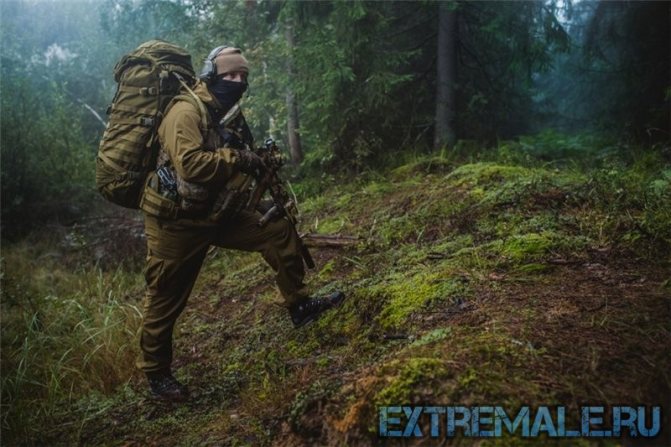
Choosing the right clothes for solo hikes is very important
The time of year makes significant adjustments to the list. Everyone has their own preferences, their own nuances, and the list is not an axiom. this is just one of the options.
Provisions
When going on a hike, take the most high-calorie food with minimal weight. If you decide to take canned food, then do not be lazy to take some semolina, after eating the canned food, pour semolina into a tin can, in a few hours it will swell and will be a wonderful, tasty and nutritious putty for bread. In general, for cooking over a fire it is better to take various instant cereals; dry noodles are also suitable. The following will be irreplaceable: dried meat and fish, dried mushrooms, nuts, raisins - nutritious, light, shelf-stable products that do not require cooking.
Important!
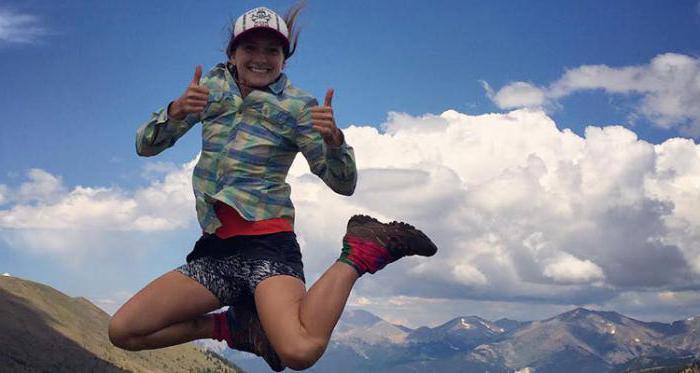
When going on a solo overnight hike, always remember that you are part of the nature around you. By deciding to move away from your usual, easier life, you have taken a big step towards yourself. Do not despair in difficult situations, you need them so that you become stronger, more attentive and decisive. Overcoming obstacles, changing each time, changing your view of the world, you change this world for the better. Good luck!


